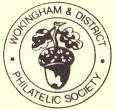10th December 2019 - Seasonal Displays and Christmas Social
Seasonal displays were provided by the following members:
Christine Earle, who showed Christmas Aerogrammes and Christmas Maxi-cards.
Alastair Nixon, who displayed German Christmas Miniature Sheets.
Trevor Cornford, who showed Polar Expedition material.
Michael Curling, who had brought along a miscellany of items with a Christmas theme.
Mark Bailey, whose display included some 2000-2002 Christmas Labels from the Åland Islands, a 1927 Christmas Card with a metal boomerang from Australia, and AnPost Irish Stamp Bureau Christmas Cards for 1999 and 2000. Representing a traditionally decorated Christmas tree, Mark finished his display with a Liechtenstein Christmas 2019 maxi-card of a Nutcracker CHF 1 stamp.
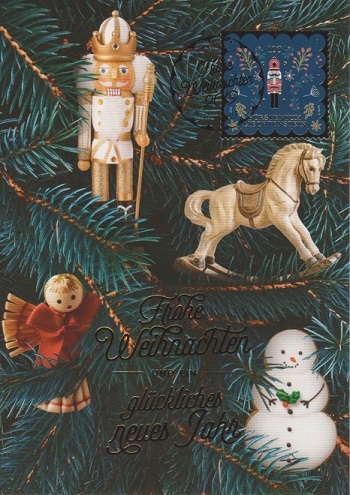
Thanks were given to Alwyn Lowe and Susan Greenwood for organising the food, and thanks to all members who contributed, with a special thank you to Mrs. Gerken for her most excellent cake.
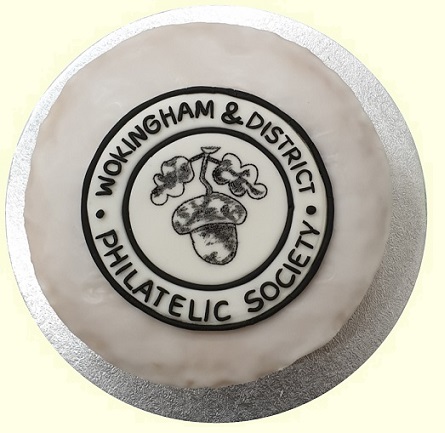
12th November 2019 - South of the Equator
The first member to display items relating to the topic of South of the Equator was Alastair Nixon. He displayed a selection of Western Australia publicity folders giving the history of 17 different Post Offices. They were issued to celebrate the 150th Anniversary of the settlement of Western Australia.
Brian Pugsley followed with Solomon Islands King George VI material. Printing was undertaken by De La Rue and Waterlow, and the different versions of the King's head can be distinguished. Brian included a flaw on the Royal Silver Wedding issue and a forged "missing perfs at top".
Trevor Cornford displayed a range of items found in a dealer's £1 box. He included material from South Africa, Pitcairn Island, French Polynesia, Tristan da Cunha, and the Falkland Islands He concluded with an article from the Illustrated London News with a picture of Capt. Scott's team, followed by a couple of letters from members of Scott's team.
Michael Curling showed postal stationery from the Australian States (South Australia, New South Wales, Tasmania, Queensland, Victoria, and Western Australia), followed by stationery from New Zealand.
Mark Bailey showed Antarctic material, including 1988 Greenpeace Worldpark Antarctica mail and cinderellas, Argentinian base mail from 1951 and a 25th Anniversary cover, and covers from the first tourist voyage in 1958. These were followed by a postcard from Deception Island, 3 miniature sheets of Argentinian stamps and material from Ushuaia, and a cover from a German ship. He concluded with items from the Byrd expedition and two Russian base covers.
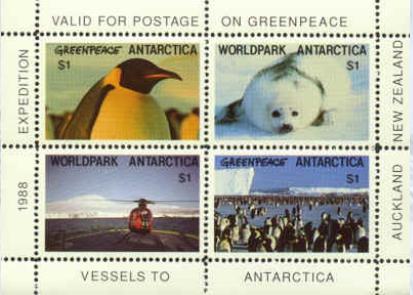
Derek Steele closed the first half with material from the Falkland Islands and Chile, a cover from a pilot stuck in Ushuaia, stamps from the British Antarctic Territories, material from Danish, Ukrainian and Russian Antarctic bases, and finally a cover from the first Transatlantic Crossing.
The second half was started by David Walker, who showed material relating to the Japanese army officer and explorer Lt. N. Shirase (1861-1946). He led the first Japanese Antarctic Expedition, 1910 to 1912.


Roger Sammons displayed Tristan da Cunha stamps from 1999 to 2003.
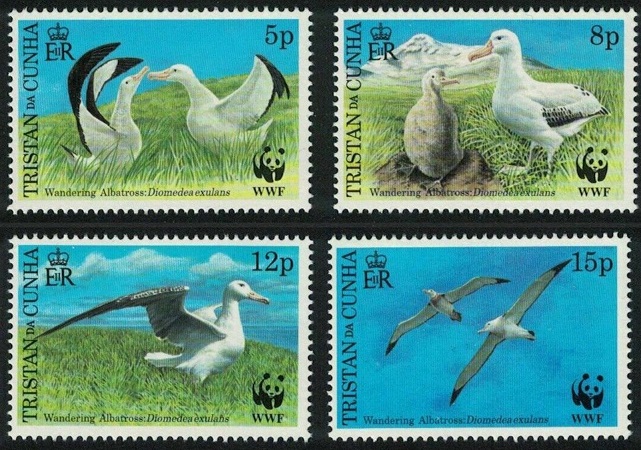

Susan Greenwood showed a range of Orchid covers that she had acquired from other members during the evening.
Alwyn Lowe displayed stamps issued by countries south of the equator that celebrated the centenary of the death of Rowland Hill, covering countries from Aitutaki to Zambia.


Chris Rayner showed material from several islands in the South Atlantic; Ascension, the Falkland Islands and Dependencies, St Helena, and Tristan da Cunha.
Patrick Reid rounded off the evening with a display of the range of tax handstamps introduced from 1948 in Victoria, Australia. All are scarce, and five of them are the only recorded examples.
Chairman Mark Bailey thanked all who had brought such a wide variety of material for the entertainment of the members.
24th September 2019 - New South Wales
The subject for the evening was New South Wales, but unfortunately Graham Keates who was going to speak on this subject had been taken ill the preceding Friday. Patrick Reid agreed to provide the display for the evening. Not wishing to depart too far from the topic, he brought along his collection of New South Wales Postage Due material.
Patrick explained that it is part of his collection of "Underpaid Outgoing Mails of Australia 1891-1965" which covers all of the Australian States, but by some margin it is the largest part. This arose largely because much of the mail that left Australia for other countries travelled through Sydney.
As an introduction, Patrick explained the UPU rules for marking of underpaid mail, and how these rules were adjusted over time to reflect the realignment of currencies and the effects of inflation. The system has a simple concept at its heart, that each country should only have a single extra currency to deal with, the (gold) centime. If Country A detected underpayment, then that underpayment was signified by marking the item with a T in black or blue and converting the deficiency into centimes at a pre-set rate. On arrival in Country B, the amount was doubled and converted to the local currency as an amount to be collected by the Post Office. In 1906 it was agreed that, from 1st October 1907, the originating country would double the deficient amount written on the item before sending it on. Patrick provided a table of the changes in the conversion rate of the centime over time, but noted that, for British Empire countries only, the exchange rate remained at 1 penny = 10 centimes from 1891 to 1947. There was also a short period during World War 2 where mail between the sterling countries had the deficiency marked in sterling.
The first series of postage due markings were stylised shields inscribed N.S.W. and the amount in centimes, with values from 5 to 25, with an undenominated handstamp for other values. These were shown on cover as well as various types of handstamped T that are very scarce.

New South Wales was the only Australian state that did not change to double deficiency on 1st October. Current research indicates a date in early December 1907, when a new series of boxed handstamps, inscribed DEFICIENT POSTAGE X/FINE X bracketed together with 2X at right, was introduced. This series was in use until about 1910, when the shield series was re-introduced.
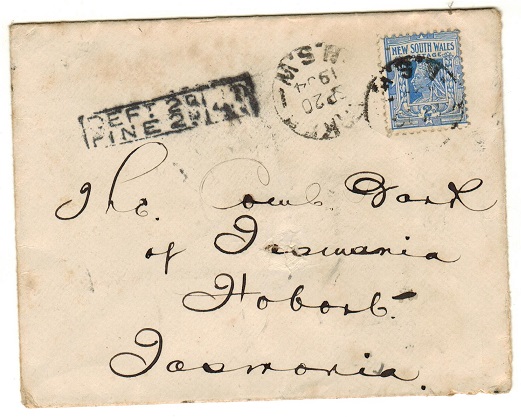

In 1922, the exchange rate became 1d = 12½ centimes, which generated the need for a 37½ centime handstamp. Examples were shown of a manuscript marking, two different crude cork handstamps and the shield-based version.
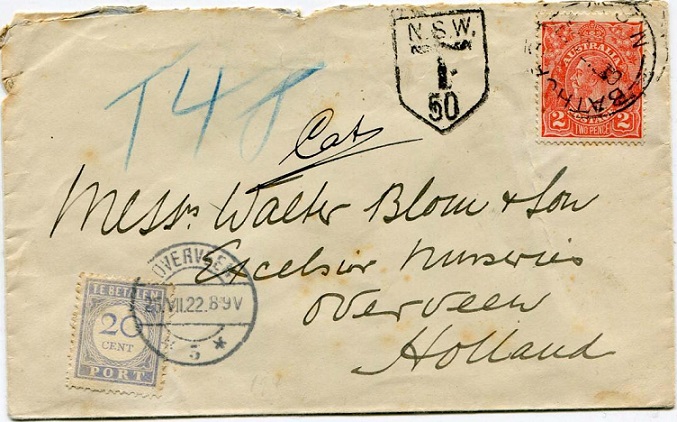
There was no need for a 12½ centime as the minimum fine was set at 30 centimes. Soon after, on 1st January 1925 the exchange rate changed again to 16⅔ centimes, but this rate only lasted until 1st October when it was halved to 8⅓ centimes with a minimum of 10 centimes. Examples were shown of handstamps for 16⅔ and 33⅓ centimes.

This exchange rate lasted until 1942, when it was again lowered to 6⅔ centimes. Manuscript markings were used until a further shield series handstamp was produced. A further handstamp in this series was for 26⅔ centimes. There were two further reductions; in 1947 to 4 centimes and in 1949 to 3 centimes. These were accompanied by denominated and undenominated versions of a different stylised shield, struck in red or violet rather than black as previously. Various values of these were shown on cover to close the first half.
The second half covered the markings that were used for Air Mail. Almost all Australian overseas Air Mail was routed through Sydney. The handstamps can be split into two groups. The first are rectangular boxes, usually with a T at the top and centimes at the base, with the value inserted in manuscript. A range of values up to 600 centimes was shown.

The second group are long rectangular boxed handstamps that include a code letter with the deficiency in manuscript. The meaning of the code letter has not been established. There is a sub-group of smaller rectangular handstamps containing the codes Air 1, Air 2, Ship 1, and Ship 2. A wide range of uses and values were shown. The display ended with a few examples of three-line boxed handstamps used for overweight items.
Deputy Chairman Alwyn Lowe thanked Patrick for stepping in at short notice and providing such a good and educational display.
10th September 2019 - Dominica - Simon Richards FRPSL
Simon Richards began by giving a brief but informative introduction to Dominica, describing the Island, its location in the Caribbean Sea and its history. The Island was named by Columbus when he visited in 1493, naming it after the day on which he arrived (dies dominica, i.e. Sunday). In 1783, possession reverted to Britain from France, who tried unsuccessfully to re-invade the Island, twice, the last time being in 1805. Dominica was part of the Leeward Islands until December 31 1939, after which it was transferred to the Windward Islands.
The presentation focussed on the period between 1763 and 1954, with a superb display of covers and stamps, including examples of all issues of the period. A selection of die proofs, before and after hardening, and items of pre-printed stationery were also shown.
The GPO in London established a branch at Roseau in 1845, using a handstruck mark "Paid at Dominica". British stamps were the first to be used, with the A07 obliterator. Dominica issued its own stamps on 4th May 1874, a set of 3 comprising 1d, 6d and 1 shilling values. Queen Victoria was pictured on the stamps in a frame bearing the words Dominica Postage.
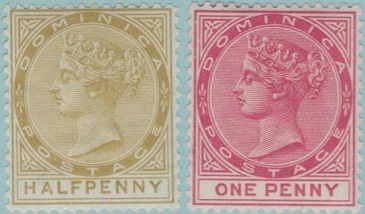
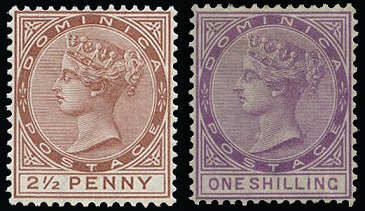
Provisional issues were also shown, including bisects bearing a half-penny and other surcharges.

Dominica used the general issues for the Leeward Islands from late 1890, but 13 years later, concurrent Dominica issues resumed. The set, with values to 5/-, showed "Roseau from the Sea", with the exception of the 5/-, which showed King Edward VII.
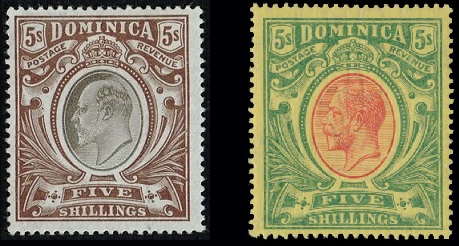
Some values were overprinted to allow collection of War Tax.

A new 5/- value was printed after the accession of King George V.
In 1922 a new set was introduced with values to £1 featuring the head of King George V and the badge of the Colony. This set was shown along with a selection of varieties and usages. The King George V Silver Jubilee issue followed.


After the King George VI Coronation Issue (part of the Omnibus issue), a completely new definitive set, featuring four different local views, was issued in 1938 with values to 5/-, with additional values being added later, including a 10/- in 1947.

At the end of 1939 Dominica left the Leeward Islands, and the Leeward's stamps were no longer valid for postage. In 1949 the currency was changed to the British West Indies Dollar (100 cents). The George VI set was reissued with a different head of the monarch and cents and dollar values.

The display ended with the New Constitution stamps, overprinted on four of the decimalised definitives, just before the issue of Queen Elizabeth II definitives.

Simon has done pioneering work on the Postage Rates of Dominica, notably concerning wartime surcharges between 1940 and 1952. This was illustrated with usages.
During the evening, Simon was happy to answer questions from members of the Society and to provide additional information where appropriate. The proceedings ended with a vote of thanks, and a small presentation was made to the Simon as a token of the Society's appreciation.
13th August 2019 - The Number Seven
The first of our members to show material on the subject of the number 7 was Dennis Proctor. He displayed seven sheets of material from seven different German States or City States.
Ron Stone showed Andrew Jackson, the seventh US President, and Franklin Delano Roosevelt, the seventh US President to die in office.

Alastair Nixon had brought along 10p stamps with seven digits in the margin (the seventh is a checksum). He lives at house Number 7 and showed mail to this address in the seventh month. Finally he displayed a very rare machine cancel featuring "one giant step for man, one giant leap for mankind" dated 19/7.
Mark Bailey showed 7 sheets of Postal History from Cheddar, which was the No. 4 Receiving House for Wells. This included undated Cheddar cancels, supplemented by dated cancels for Wells. There are three Cheddar undated circular handstamps in the Steel Impression Book, and Mark showed examples of usage of all three. Nearly all the material was from one correspondence, between William Tanner and Sarah Wheeler.

Derek Steele explained that he had misunderstood the topic and had brought along material for the Letter S. He showed the Scottish Wheel Tax with a range of the marks and some of the related books.
Michael Curling displayed a range of cards and letters relating to King Edward VII. These included a card of the King, a card for his Coronation, an Ottmar Zieher postcard with the wrong head of the King on the stamps, a photograph of the Royal Party at Windsor, a visit to Ascot Races, a Christmas postcard, a card for the King's Funeral, a letter from Queen Alexandra, and a photograph of the King with his dog.
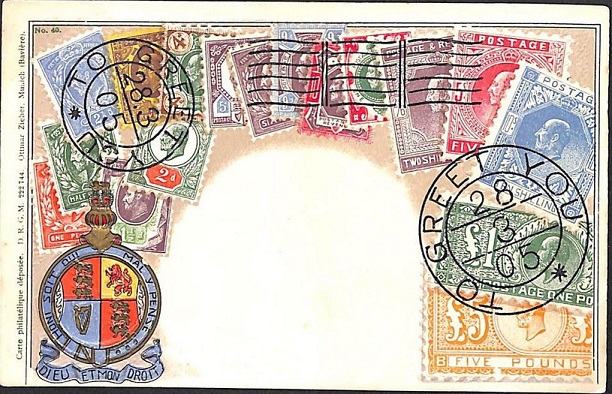
Alwyn Lowe showed a selection of King Edward VII Postal History, including letters, postcards, wrappers, and letter cards. Some of these bore instructional markings. He also showed Taff Vale Railway material.
Patrick Reid brought proceedings to a close with seven sheets showing the many uses of the Tasmania £1 Tablet stamp in plain and overprinted form.

23rd July 2019 - Annual General Meeting
The Annual General Meeting was held on 23rd July 2019, and in his report, the Chairman thanked the various members who run the Society and those who help during its meetings. He noted a good level of attendance at the meetings, and concluded it had been another good year for the Society.
The Honorary Treasurer's report was read and the accounts circulated. The Honorary Secretary made his report, and the Packet Secretary made his report. The Membership Secretary reported that the membership stood at 68 members. The Committee recommended that the annual subscriptions would remain the same, and this was accepted at the AGM.
As a result of the election of Officers and Committee, Brian Pugsley stood down, and Patrick Reid was elected, as the Society's President. Alwyn Lowe was elected as the Competition Secretary, replacing Derek Steele in that role. All the other Officers and Committee members were re-elected.
9th July 2019 - The Steam Railways of New Zealand - Lorraine Maguire
To assist in our understanding of the subject, our guest speaker Lorraine Maguire brought an extensive selection of related books. She also explained that her father worked on the railway, so she was from a "railway family".
The first half of the display covered the Main Trunk Railway on North Island. Lorraine made it clear at the beginning that there was very little conventional philatelic material, but rather she illustrated her subject with a collection of postcards of railways and associated buildings.
From the 1870s railway lines opened up areas of New Zealand for settlement. Railways connected farms, forests and mines to markets and ports, and fostered the growth of towns. For most of the 20th century the steam railway, and its stations and refreshment rooms, were a familiar part of life.
The first railways were built around Christchurch in the South Island. The central North Island posed greater challenges to rail-builders than the South Island's eastern plains. A main trunk railway between Auckland and Wellington was discussed from the 1860s, but progress was slow. By 1880 Auckland's southern line reached Te Awamutu, and there were isolated sections of line between Wellington and Wairarapa, and in Taranaki, Manawatū and Hawke's Bay. Further progress was blocked by rugged mountains, dense forests and the Māori stronghold of Te Rohe Pōtae (the King Country). Despite these challenges, exploratory survey work began in 1882. Two years later a Parliamentary committee opted for a central route rather than western or eastern alternatives. The government also reached a crucial agreement with Ngāti Maniapoto leaders to open up the King Country to the railway. It would take 23 years to complete the 425-mile North Island main trunk. Progress was slow in the 1890s, but work intensified after 1900.
By 1904 the northern and southern sections had reached Taumarunui and Taihape. South of Taumarunui, the steep climb up to the Waimarino plateau was accomplished via the famous Raurimu spiral, which featured two tunnels, three horseshoe curves and a complete circle. Towering steel viaducts bridged deep ravines at Makatote, Hāpuawhenua, Mangaweka, Makōhine and elsewhere. The entire North Island main trunk line was formally opened in 1908. As a result of the geography, there was originally no connection to the West Coast, and this was a problem, eventually overcome.
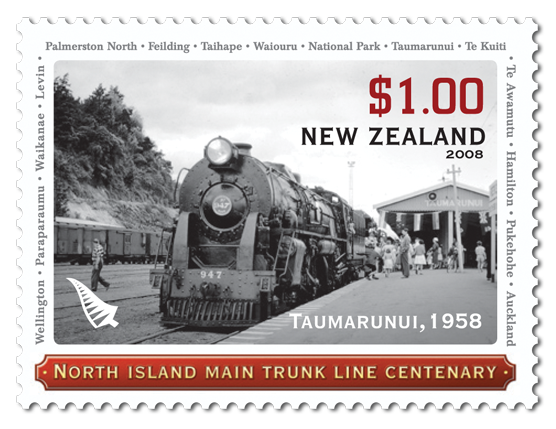
The railway led directly to the wharves, to provide support for goods unloaded from ships. There was a major shunting yard at Thornden, and Palmerston North was a major junction; until 1963 the main trunk railway line ran through the centre of Palmerston North.

The country is very hilly, so there are many viaducts and a number of major tunnels. Electric locomotives were used only to pull trains through the tunnels. Modern development has seen the introduction of some major deviations to allow the use of new bridges that make the line safer.
Long distance journeys had a number of refreshment stops (lasting just seven minutes), and there was a special stop at Oamaru where a full dinner was served (and eaten) in 22 minutes.
The highest station is at Waiōuru, 2500 ft above sea level. The worst railway disaster was at Tangiwai near Waiōuru in the central North Island on Christmas Eve, 1953. A lahar (a slurry of rock, water and pyroclastic material) from Mount Ruapehu rushed down the Whangaehu River, partially destroying the railway bridge. A few minutes later the Wellington to Auckland express train reached the damaged bridge. The driver of the train tried to stop, but the train ran onto the bridge which collapsed into the torrent. The locomotive and six carriages were derailed. Despite the brave efforts of rescuers in the dark and dangerous conditions, 151 of the 285 people on the train died. This was illustrated by contemporary postcards.
The original Auckland Station had been on the outskirts of the city. On completion of the railway it was moved to the city centre. Now, it has once again been moved to the edge of the city. There are now a number of preserved railways in New Zealand, and Lorraine showed a selection of cards from them.
The next section covered Travelling Post Offices, which replaced coastal steamers. We saw commemorative stamps, and cards of relevant lineside equipment. Evidently mail bags were thrown off at stations, often hitting milk churns or other items on the platform.

In order to get to Napier, the Manawatu Gorge had to be traversed. A landslip in the gorge wrecked a train and the mail van. This led to trains being reconfigured with the Mail Van at the end.
Finally in this section, we saw cards illustrating the damage caused by an earthquake that destroyed Napier in 1931.
The second half of the display concentrated on the South Island.
The South Island's main trunk line was completed in the late 1870s. Christchurch was connected to Timaru in 1876 and to Dunedin two years later, cutting travel time between Christchurch and Dunedin to around 11 hours. The final section between Dunedin and Invercargill was opened, amid much fanfare, in January 1879. More than six decades later, in 1945, the main trunk line was extended north to Picton. The crossing from Wellington to Picton is by ship, but in 1960 Roll-on Roll-off ferries were introduced that allowed carriages to be transported to travel through to Christchurch on the East Coast. The line features many river bridges and these were illustrated by cards. It is possible to travel beyond Christchurch to Lyttleton. We also saw cards of Christchurch prior to the (relatively) recent earthquake that destroyed many buildings, including the Cathedral.

Next came a section on the Midland Line, now known as the Transalpine Line. Lorraine advised us that if we travel on this line to be sure to sit on the scenic side. The line runs through to Greymouth and to Westport for the mines. The line down to Dunedin, where there are workshops as well as the Station, used to continue to Bluff, the most southerly port in New Zealand.
Lorraine explained about the different types of locomotives. The New Zealand post office issued a set of 4 stamps featuring steam locomotives in 1973, 2 years after steam engines had been completely replaced by diesels. The W-class tank locomotive on the 3c stamp was the first engine built by the New Zealand Railways workshops in 1889. The X-class locomotives, as seen on the 4c stamp, first built in 1908, were among the first four-cylinder compound locomotives in the world. The AB-class was for many years the workhorse of New Zealand rail. Between 1915 and 1926, 141 were built, and engine No. 608, pictured on the 5c stamp, was named Passchendaele and carried a memorial plaque to commemorate the First World War battle. The JA-class engine No. 1274, which featured on the 10c stamp, was the last of the 35 of this class. It was the last steam locomotive built in New Zealand, in 1956.

The next section included cigarette cards of trains, a range of pictures and cards showing engines, examples of Parcel and other labels and a selection of Tickets. From 1890 to 1925, New Zealand Rail issued special stamps for transport of newspapers by rail. There were six values - ½d, 1d, 2d, 3d, 4d and 6d - all with the same design.
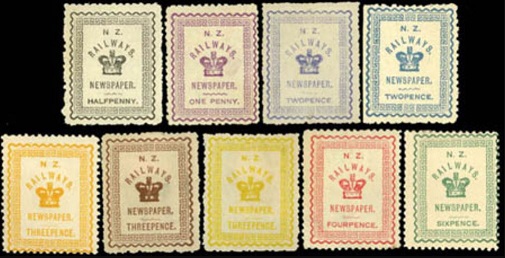
Lorraine completed her display with details of a railway near Wanganui where tourists can drive themselves on the line in converted golf buggies.
Mark Bailey gave the Vote of Thanks for a fascinating talk, which had included many personal stories that brought the material to life.
25th June 2019 - On the subject of Holidays
Patrick Reid started the evening's displays with a wide-ranging selection of Tourism material from Tasmania, beginning with the Pictorial stamps and including Hotel postcards and promotional envelopes. He also showed a section devoted to Gustav Weindorfer, the Austro-Hungarian Consul in Melbourne, who fell in love with the Cradle Mountain area and with his wife Kate, a Tasmanian woman 10 years his senior, built a rest home and guest chalet in 1912, naming it Waldheim, meaning 'Forest Home', which became a tourist destination.
Susan Greenwood goes on holiday to see orchids, and she displayed material from seven years of Swiss holidays exploring for orchids. She now goes on specialist organised trips. She showed orchid covers relating to holidays that she has taken around the world, and ended her display with a book of orchid stamps from a visit to China.
Alastair Nixon collects Tourist Attractions through the medium of meter franks. He gave us a Cook's Tour of England through meter franks. Beginning in London, he moved on to Kent (Leeds Castle), Sussex (Chichester cathedral), through Buckinghamshire (Bekonscot), Berkshire (Beale Park), Dorset (Tank Museum and Corfe Castle), Wiltshire (Stonehenge), Cornwall (Dartmoor) and Devon (the Donkey Sanctuary at Sidmouth), Somerset (West Somerset Railway) and Avon (SS Great Britain). Moving on through Wales (Gower Peninsula, Talyllyn and Ffestiniog Railways), his tour reached the North of England at Blackpool Tower. His display continued to cover a long list of places of interest, including The Britannia and Forth Bridges, The Angel of the North, Bressingham Museum, and famous buildings such as the Bodleian Library in Oxford and Bletchley Park. Alastair demonstrated that the meter franks were originally in red, but since 2013 they have been in blue.


Trevor Cornford showed postcards of various places dating from the 1900s. He recalled a trip to the Clifton Suspension Bridge and the Avon Gorge, and fondly remembered belonging to the Dan Dare Society.

From Russia, Trevor displayed a card of Red Square, Moscow. He then recalled a cycle tour of Sri Lanka, including a visit to Sigiriya (the Lion Rock). He showed a contemporary card and some tea-related letters. Shifting to his usual polar theme, he showed transcripts of letters from Henry Robertson Bowers (29 July 1883 - 29 March 1912) who was one of Robert Falcon Scott's polar party on the ill-fated Terra Nova expedition of 1910-1913. Trevor concluded by saying that "The Antarctic is calling me for a holiday".
The final display was from Roger Sammons, who enjoys holidays in Greece in an apartment near Cape Sounion. He showed Greek stamps from 1971 to 1975, including costume sets, Europa stamps and Musical instruments.

Alwyn Lowe thanked all who had brought material, which as ever showed considerable variety.
14th May 2019 - Members' Silent Displays
At the start of the meeting, Patrick Reid presented Certificates to David Walker for his recent entries in the Thames Valley 9-sheet Competitions. Then, the members were entertained by displays given without commentary, in which "the sheets spoke for themselves".
David Gerken began with "Bridges that he has been over or under". This included material relating to the Sydney Harbour Bridge, progressive proofs of the 1968 1/9d M4 viaduct stamp and items for other bridges he has visited. Patrick Reid showed Tasmania Impressed Duty Stamps, Alan Kane displayed a range of Northern Ireland cancels, and Dennis Proctor showed GB Queen Victoria from the 1d Black to the Jubilee issue (excluding High Values), with many 1d Red plates (though no Plate 77 or Plate 225!).
Trevor Cornford showed the British Antarctic Territories and a pot-pourri of other material including cards of Reading 1915-17, 1950/60 cartoon originals, and Dickens stamps (Cinderellas).
David Walker showed Mexico - the Centenary of the Arms issue. Roger Sammons displayed British Guiana varieties, and Richard Jenkins showed German postcards with commemorative cancels for Stamp Fairs. Alwyn Lowe displayed some of the stamps issued for the Europa 50th Anniversary, and Derek Steele showed Newfoundland and Canada Airmails.
Alastair Nixon showed the full set of GB Slogan Cancels for 2019 (so far), and Michael Curling completed the evening's displays of a wide selection of subjects with local ephemera and Sandhurst postcards, including the Chapel, the Village, Blackwater Bridge, and the College and grounds at the Royal Military Academy.
23rd April 2019 - The Allied Occupation of Austria, 1945-1955 - Colin Tobitt FRPSL
Colin Tobitt started by explaining that even though the former Austria was part of the Third Reich at the end of World War 2, they were quite fortunate, due to an Allied powers agreement concerning post-war occupation policies. The Declaration of Moscow in 1943 stated that the former Austria would be regarded as the first victim of Nazi aggression and treated as a liberated and independent country after the war.
Colin began his display with a 1943 leaflet that had been air-dropped over Austria by British, American and Russian planes, promising release from German domination.
On 29 March 1945, the Soviet army crossed the border into the former Austria, and Karl Renner, then living in Lower Austria (Niederösterreich), contacted the Soviet government. On 20 April 1945 the Soviets asked Karl Renner to form a provisional government, and on 27 April 1945 Renner and his cabinet ministers declared Austria's independence from Germany and called for the creation of a democratic state along the lines of the First Republic of Austria.

The states of Niederösterreich and Burgenland (and initially Steiermark) were controlled by the Soviet Union. By May 1945, French, American, and British armies had taken control of the Western portions of the former Austria. The borders of the four Allied occupation zones were established by July 1945, with the city of Vienna being declared an international zone, as shown on the map above. The states of Oberösterreich and Salzburg were controlled by the United States, Steiermark, Kärnten and Eastern Tirol were controlled by Great Britain, and Vorarlberg and Northern Tirol were controlled by France.
Austrian stamps began to re-appear in May 1945. One thing the new provisional government in the Soviet occupation area of Eastern Austria needed desperately was a working postal service. At the end of the war, the one thing in abundant supply in Austria was a very large inventory of unused Third Reich definitive postage stamps, especially those featuring the portrait of Adolf Hitler, and the new occupation government made full use of them in the ensuing months!
In the zone occupied by the Russians, Russia overprinted stamps for use on Soviet posts, and there are many varieties. These overprints were applied to existing stocks of German definitive postage stamps, commemorative stamps, and charity stamps. These occupation stamps were all denominated in Pfennigs and Marks. Colin showed examples of usage with both local and overseas rates.
The display of Nazi symbols was forbidden, and the overprinting of the stamps obliterated Adolf Hitler's head. There are around 400 varieties of this, and many forgeries as well. Postal stationery was also overprinted. To increase supply, some local printings were made.

The four Soviet occupation of Austria stamps shown above were overprinted, for use in Vienna, Niederösterreich, and Burgenland, at the beginning of May 1945. These are the only four denominations that were regularly issued. These overprints, and other similar obliteration markings, exist on other denominations, but they were never issued, and they are very rare.
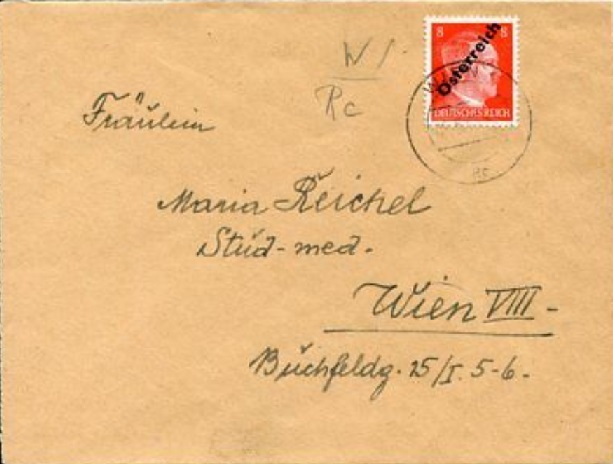
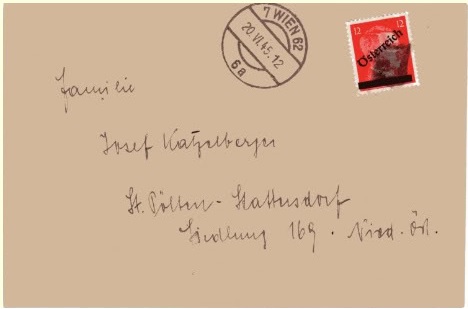
The Russians ransacked everything and this gave rise to a number of provisional cancellations to keep the system working. There were restrictions on who you could correspond with and picture postcards were disallowed. Censor marks were put both inside and on the outside of covers. Colin showed examples of official mail including telegrams.
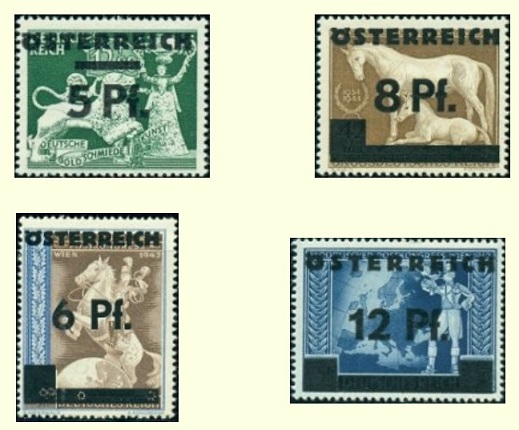
The four Third Reich charity stamps shown above were officially overprinted and re-valued for use as Soviet occupation definitive postage stamps at the beginning of June 1945. Concentrating on the Russian Zone, Colin showed censored covers with differing sizes of fonts, including a letter to Alwine Dollfuss, the widow of Engelbert Dollfuss. Some letters from outlying regions were sent to Vienna for censorship, where there were about 1000 censors. No exchange of Postage Stamps was allowed.

A new style of overprinting of the definitive stamps was also officially issued at the beginning of June 1945. These stamps had the diagonal Österreich overprint, but they also had vertical bars obliterating the profile of Adolph Hitler.
.


The four high-denomination overprinted stamps shown above were not delivered to post offices. However, they were sold to stamp collectors. The 2 Mk through 5 Mk denominations exist both perforated 12½ and perforated 14. The perforated 12½ varieties are the scarcest. There are overprint errors on almost all of the obliteration bar overprinted stamps.
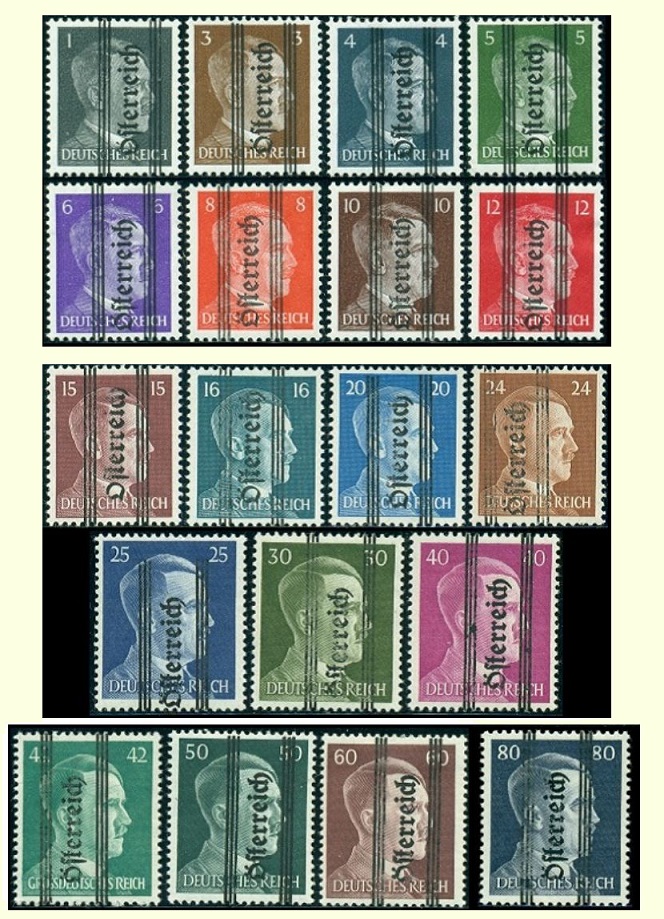

The Soviet occupation Austria stamps shown above were overprinted during May and June 1945, with the 4 high denomination stamps being overprinted in June 1945. They were a local issue for the Soviet Army, used during their temporary occupation of Steiermark.
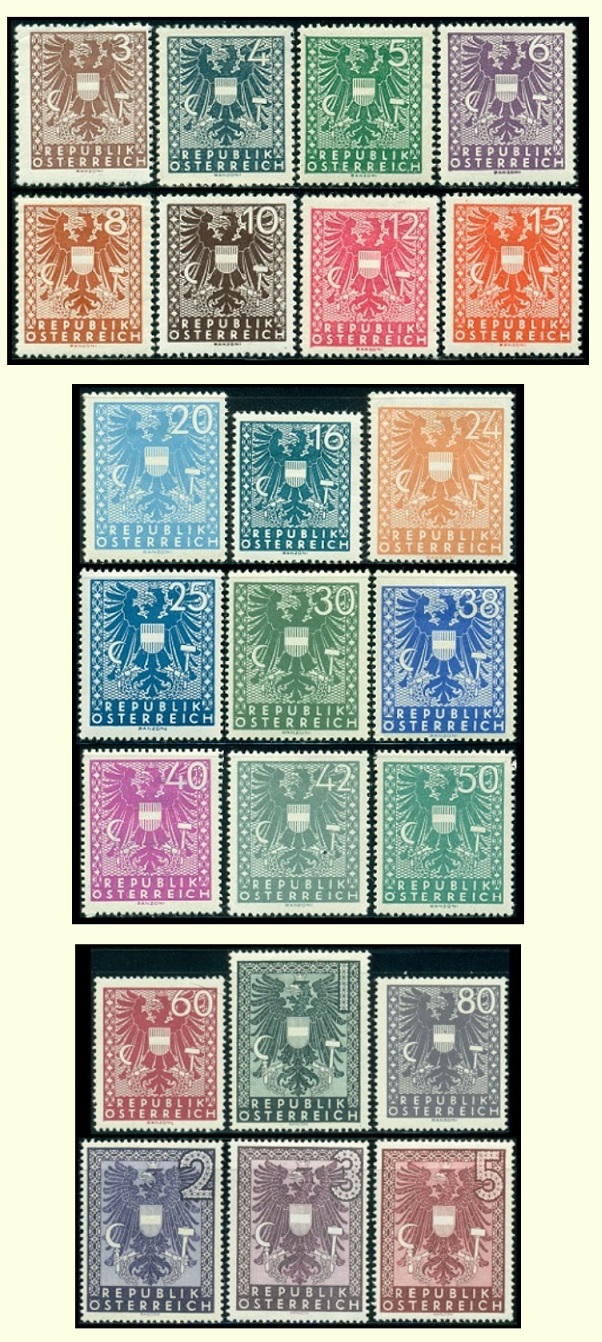
23 new Soviet occupation stamps as shown above were issued between July and November 1945, for use in Vienna and the Soviet occupied provinces of Niederösterreich and Burgenland. The design features the Austrian Eagle holding the Soviet hammer and sickle, and the stamps are inscribed "REPUBLIK ÖSTERREICH".
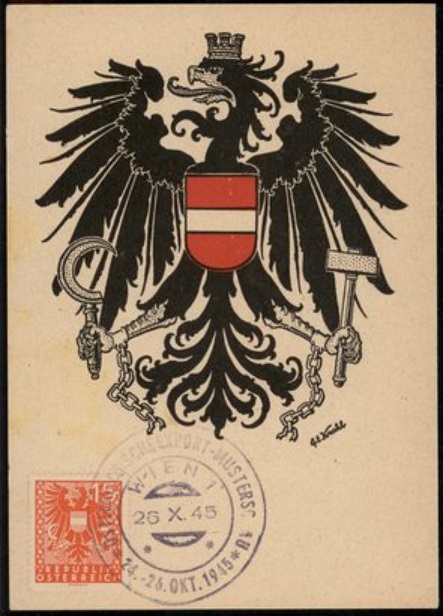
In October 1945 an Export Exposition was held in Vienna, and Austria 1945 Liberation postcards, with broken chains on the eagle, were used as advertising cards with the event cancel on the new stamps.
The first elections of the Second Republic of Austria were held in November 1945, with Karl Renner becoming the President and Leopold Figl becoming the Chancellor.
To complete the first half of his display, Colin turned his attention to the American zone. The American zone had censorship based in Salzburg and Linz. They used a censorship system with resealing tapes. Items that they were unsure about could be taken out of the system and put back in later. The overfranking of letters to Germany was forbidden. Telegrams were also censored until 1953.
|

|
Shown here is an American soldier's pass for access to travel through Soviet, French, and British zones of occupation in Vienna. While British and French zones generally offered easy travel access, Cold War tensions between the US and Soviet Union often made passing through Soviet sectors risky and potentially hostile.
The second part of Colin's display continued with the US zone, for which the Americans printed stamps. They also overprinted the stamps PORTO for Postage Due, and confetti from the perforations affected the overprints.
The Americans used their Forces APO system to transmit the mail, and Parcel Labels were used for an "Avis de Reception (AR)" system.
New Austria stamps were issued by the Allied Military Government (A.M.G.) of the United States, Great Britain, and France from the end of June 1945. These A.M.G. stamps were issued for use in all of the Western Austrian states occupied by the United States, Great Britain, and France, and they were not valid for postage in the Soviet Union occupation zone. All of these A.M.G. stamps were denominated in Austrian Schillings and Groschen.
|

The A.M.G. stamps shown above were printed in Washington, D.C. and issued in Austria between June and November 1945. They are lithographed and perforated 11. The printing was evidently done with great urgency and not very carefully! There are numerous plate faults, colour shades, and printing errors. The design features a post horn, with denomination numerals in the upper corners and the denomination spelled out at the sides. As mint and used stamps these are very common, but on commercial covers they can be quite scarce.
The French zone was based around Bregenz, and postal material is hard to find. Colin showed a range of Censor marks consisting of three letters, some of which are very scarce. He also displayed a telegram and a range of military covers.
The British Zone forces were the last to arrive, having come via Sicily and Italy. Colin showed censor marks and checking marks. Initially they used the American Zone censorship, but later moved to British censorship based in the Schönbrunn Palace. The British airfield was in an adjacent field, as the Russians had the main Vienna airfield.
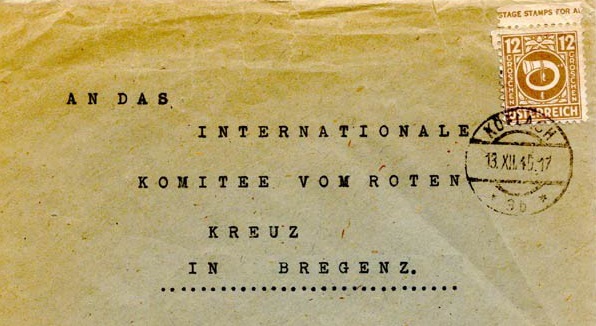

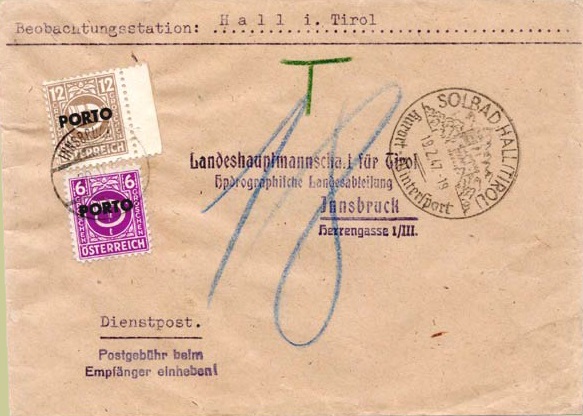
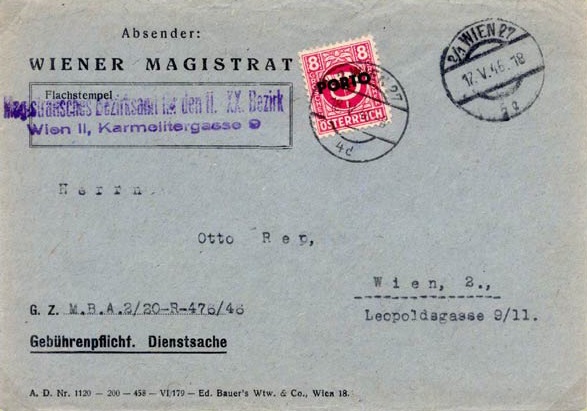
Colin showed examples of Ration Cards and money from all four Zones, followed by a selection of Charity stamps. He followed with examples of forgeries; forged covers to real people and forged FPO numbers.
The termination of postal censorship in the Soviet zone was announced on 12 August 1953, and 2 days later, the Allied Council decided to end controls of letter, telegram and telephone communication in all of Austria. Censorship of domestic postal services had ended in 1946, but the surveillance of international communications of all types had continued. When the Allied postal censorship ended, about 1 million confiscated letters and large numbers of publications were in the basement of the main post office in Vienna, together with approximately 3,000 registered items. With the closing of the censorship office, the Allied Commission decided, with few exceptions, to have this seized mail pulped, together with the office's records and files.

The occupation came to an end on 15th May 1955. The British delegation in the Sacher hotel, the American delegation in the Bristol Hotel, the Russian delegation in the Imperial Hotel and the French delegation in the Hotel Le Grand all lowered their flags at the same time to mark the event.
The Chairman Mark Bailey gave the Vote of Thanks, commenting that Colin had shed light on events of recent history that were not well known.
26th March 2019 - Chairman's Evening
Chairman Mark Bailey provided a display covering 80 years of the PRAGA philatelic exhibitions held in Prague, from 1938 to 2018.
Mark explained that philatelic exhibitions have a long tradition in what is now the Czech Republic. From modest beginnings in the late 19th century, with the first Czech stamp club in Prague forming in 1887, it proceeded to the first International Exhibition held in Prague, PRAGA 1938, which marked the 20th anniversary of the first Czechoslovak postage stamps.
The first worldwide exhibition, PRAGA 1962, was also held there, nearly a quarter century later. Since 1968, these global exhibitions have been held every 10 years. PRAGA 2018 commemorated the 100th anniversary of Czechoslovakia and the 25th anniversary of the Czech Republic.
Mark's display showed numerous stamps, miniature sheets, postal stationery cards, and souvenir items issued to publicise and commemorate each of these PRAGA exhibitions. The material included in the display was not only from Czechoslovakia (in later years the Czech Republic) but also from the other countries that took part in the events.
PRAGA 1938 took place between 26 June and 4 July 1938, and the exhibition was held in several locations in Prague. The PRAGA 1938 exhibition was commemorated with a miniature sheet of two stamps issued by the post office, and souvenirs of the exhibition were available once PRAGA 1938 opened. The souvenir postcard features a post coach. Sheets of 10 souvenir labels were available, showing scenes in Prague and the Czech countryside, and were printed in 5 colours.

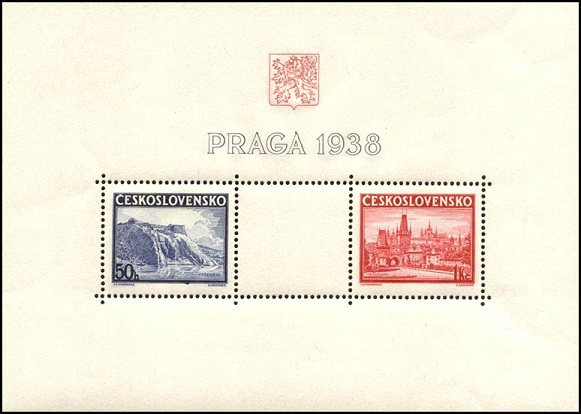
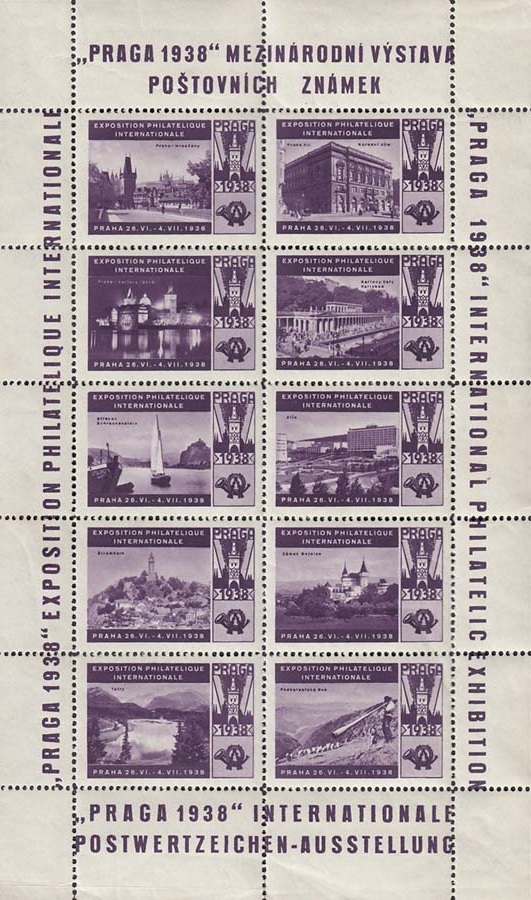
However much the exhibition PRAGA 1938 was successful attracting the attention of the whole philatelic world, World War II limited the possibilities to organize a similar event. The first attempt to do so after the war occurred in 1950, when a group of Czechoslovak collectors tried to organize PRAGA 1950 as an international philatelic exhibition. Unfortunately for many reasons the attempt was not successful. These included a lack of money, as it was primarily needed to finance post-war reconstruction of Czechoslovak industry, and also internal disputes among the stamp collectors. Thus PRAGA 1950 was a National Postage Stamp Exhibition. This meant that philatelic souvenir labels that had been prepared for the international exhibition (intended to run between 20 and 29 May 1950) were printed but not used. The national exhibition was held between 28 October and 5 November 1950.

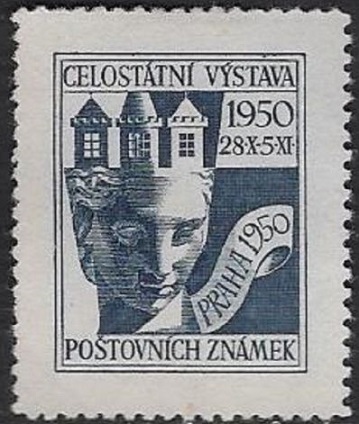
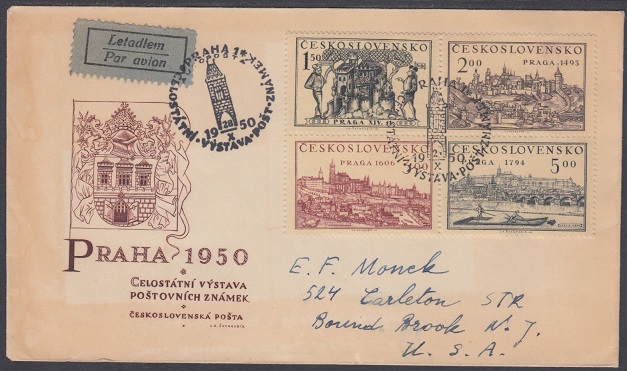
The first post-war International Stamp Exhibition PRAGA 1955 was held under the auspices of the President of the Republic and with the support of the Fédération Internationale de Philatélie (FIP). It took place between 10 September and 25 September 1955.
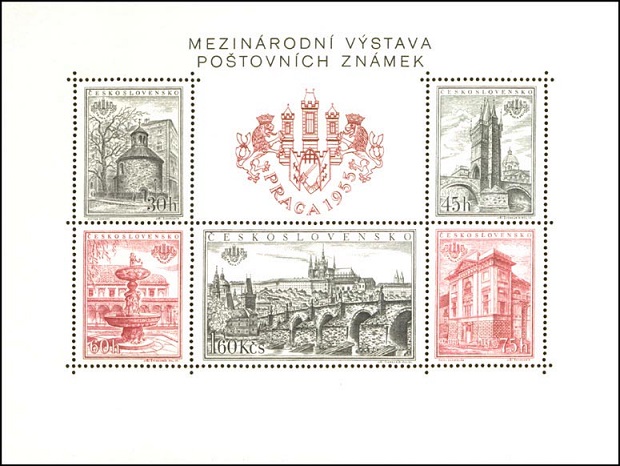
As a result of the discussions at their congresses, the FIP approved the idea that the first World Stamp Exhibition in philatelic history be organized in Prague. PRAGA 1962 took place between 18 August and 2 September 1962. It was a totally different event from what had previously taken place. The idea of bringing philately to the working class was over, and the exhibition was open for the collectors from around the world.
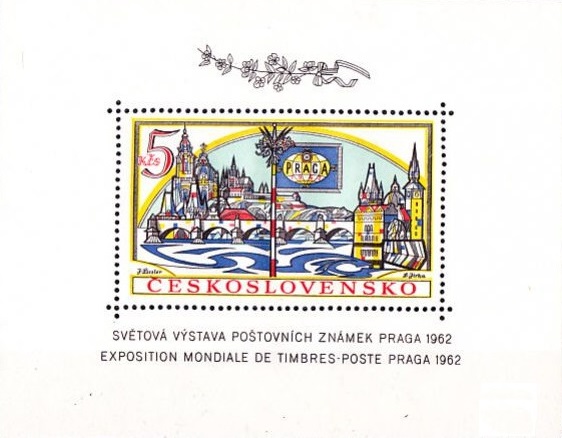

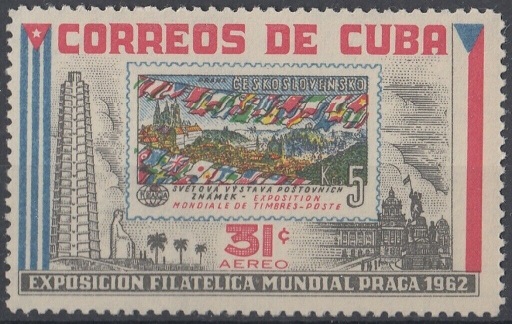
The number of visitors to PRAGA 1968, held between 22 June and 7 July 1968, was record-breaking. 345,000 people visited during the 16 days of the exhibition, of whom 60,000 people came from abroad. The most famous Czechoslovak stamp rarities were on display at PRAGA 1968, and these two stamps were also reproduced on the exhibition entrance ticket.
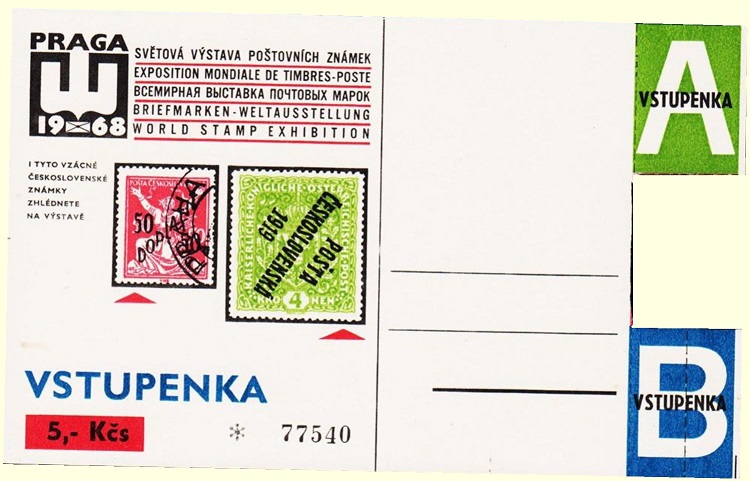
The PRAGA 1978 exhibition took place from 8 to 17 September 1978. The motto was "Postage stamps and philately - the world of knowledge and peace". There were several accompanying events, and mail was delivered by helicopters and balloons. The number of visitors was again high - 335,800 people, of whom 50,000 arrived from abroad. The entrance tickets, which could be used as postcards, carried designs of Czech stamps.
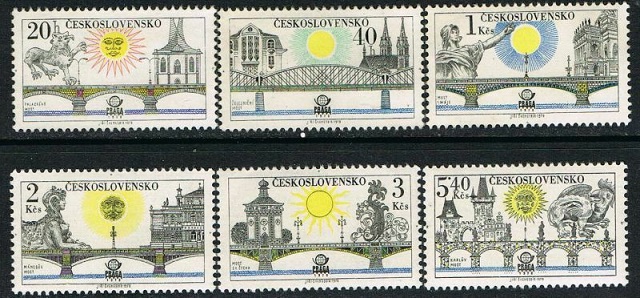

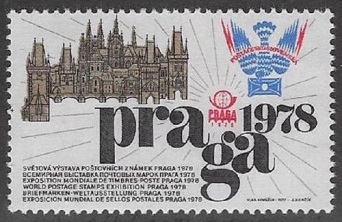
The first half of Mark's display finished with material issued by Czechoslovakia for PRAGA 1978.
The second half of Mark's display began with material issued by other countries for PRAGA 1978.

The World Stamp Exhibition PRAGA 1988 was held from 26 August to 4 September 1988, again under the patronage of the President of the Republic (who also opened the exhibition) and the FIP. 1988 marked the 60th anniversary of the FIP.
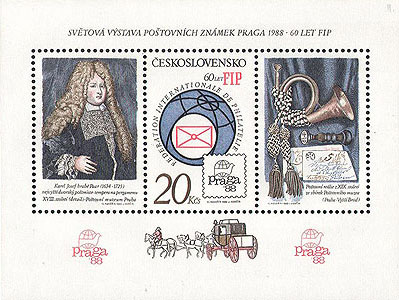
PRAGA 1998 took place from 10 September to 13 September 1998. It marked 60 years since PRAGA 1938.

PRAGA 2008 took place between 12 and 14 September 2008.
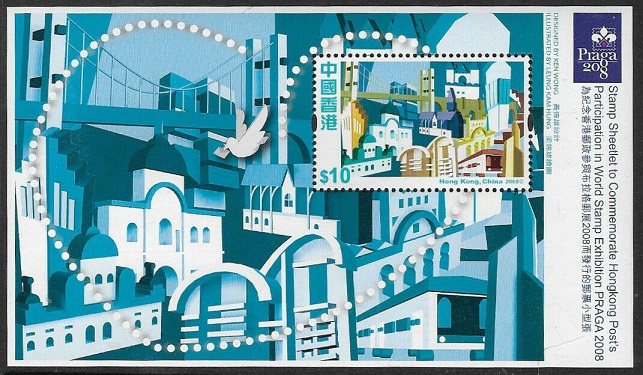
PRAGA 2018 occurred from 15 to 18 August 2018, and the exhibition and accompanying Expo sales event took place at 4 venues in Prague. PRAGA 2018 was a specialized World Stamp Exhibition with FIP patronage and Federation of European Philatelic Associations recognition, held on the occasion of celebrations of the 100th anniversary of the establishment of the Czechoslovak Republic, the 100th anniversary of the issue of the first Czechoslovak stamp, the 100th anniversary of the establishment of the Postal Museum, the 100th anniversary of the end of the World War I and the 25th anniversary of the establishment of the Czech Republic.
The objective of the exhibition was to promote philately, to develop mutual relations and philatelic culture, and to maintain cooperation among philatelists throughout the world.
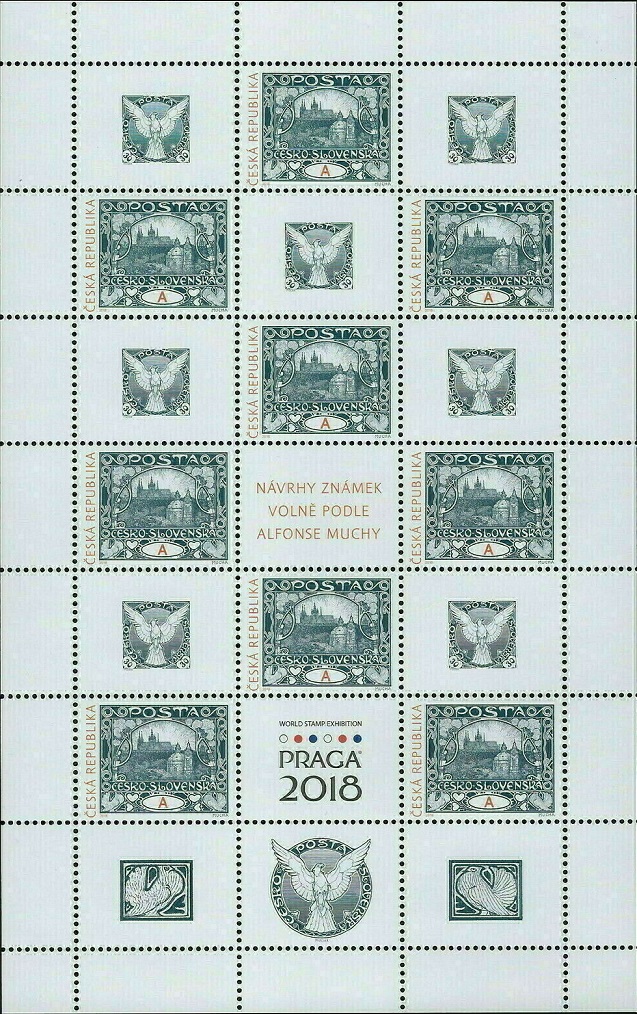
Deputy Chairman Alwyn Lowe thanked Mark for such an extensive and interesting display of a diverse range of material, all relating to the PRAGA events.
12th March 2019 - Finland at War - Michael Elliott FRPSL
Michael Elliott visited us from Sussex to tell us about Finland at War. In his introduction, he emphasised that his display was not about World War II, but about the 1939 Winter War between Finland and Russia and the 1941-44 Continuation War with the same combatants.
On each occasion, despite early gains, Finland lost to Russia.
In 1940, the Olympics should have been held in Tokyo, but World War II intervened. Finland had been the second choice as Olympic host nation, and Michael began his display with some attractive letter sheets and envelopes showing the Olympic Stadium in Helsinki.

Finland had a well-trained Army, and in 1928, 1937, and 1939 they conducted military exercises. These ensured that there was a well-established Field Post system (Kenttä Postia). It had its own cachets (which Michael had translated for us) and we saw some covers showing registration cachets.
Michael explained that the Finnish Flag and the Finnish War Flag are different. In wartime they used censorship, and we saw example covers.

In the Winter War there were specific cachets for the various regiments and the Navy. Some civilians took refuge in Northern Norway, where they were interned. The winter on 1939-1940 was hard, but saw some interesting changes of employment. Thus, football reporters were sent to be War Correspondents.
Michael explained that some letters are hard to decipher as the writers had limited literacy. During the Winter War, propaganda leaflets were dropped on the Russians, and bombing of Russian bases was reported in the Daily Telegraph.
Lotta Svärd was a Finnish voluntary auxiliary paramilitary organisation for women. Formed originally in 1918, it had a large membership undertaking volunteer social work in the 1920s and 1930s. It was formed to support the White Guard, and during the Second World War, it mobilized to replace men conscripted into the army. It served in hospitals, at air raid warning positions, and other auxiliary tasks in close cooperation with the army. The women were officially unarmed except for an antiaircraft battery in 1944. The organisation was suppressed by the government after the war. The name came from a poem by Johan Ludvig Runeberg. Part of a large and famous book, The Tales of Ensign Stål, the poem described a fictional woman named Lotta Svärd.
According to the poem, a Finnish soldier, private Svärd (in Swedish svärd means a sword) went to fight in the Finnish War and took his wife, Lotta, along with him. Private Svärd was killed in battle, but his wife remained on the battlefield, taking care of wounded soldiers. We were shown letters and lettersheets about the War, as well as a cover to Denmark that had been censored by the Germans.
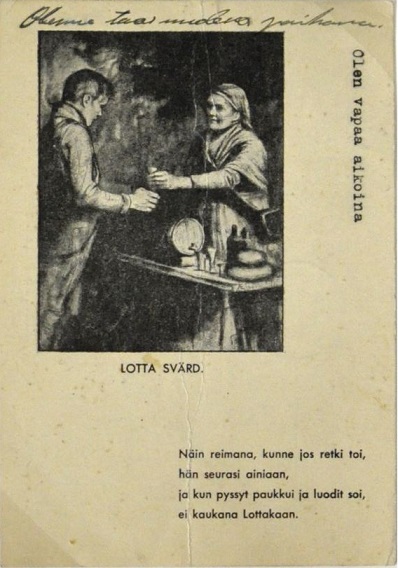
Finland did not stand alone. A group of Swedes with military experience formed the Swedish Volunteer Corps (S.F.K. Svenska Frivillig Karen). This group provided 8,260 men who gathered at the town of Haparanda, on the Swedish side of the border.
A designated Fieldpost office was established to deal with the mail to and from the volunteers, with a special postmark "Haparanda/F" being introduced on 10 January 1940. The volunteers posted their mail unfranked, and it would be gathered up and delivered to the Fieldpost office in Haparanda. Swedish stamps that had been purchased by the Sweden Finland Committee were affixed to the items before postmarking. We were shown the scarce S.F.K. Finland cancel from late in the war, when the volunteer soldiers could sent their mail for free. The Swedes also controlled 500 Norwegian volunteers, and we saw covers from them. The separate postal system closed at the end of the War.
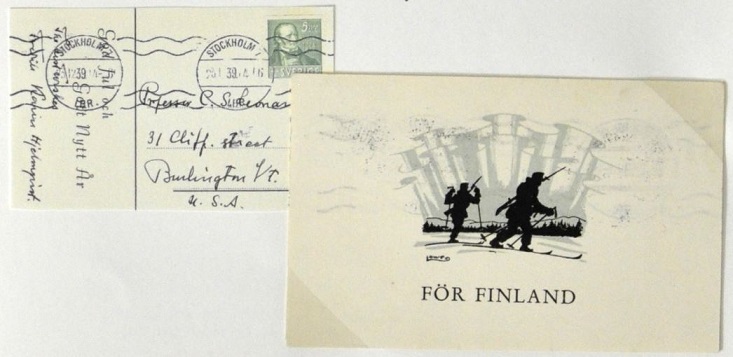


There were also some British volunteers in Finland We were shown letters from British wives of Finnish soldiers. There were also a dozen flight mechanics that helped to maintain the Finnish planes and the London Fire Brigade sent a Fire Engine.
At the beginning of the second part, the story continued. At the end of the war, an "Interim Peace" existed, and Finland had to cede territory. The War officially ended in March 1940. A philatelic product was an unofficial bisect, which was shown on cover. As part of the Treaty, the Forces Post ended.
Some Finns volunteered for the Spanish Civil War, and we saw a cover from one of them.
In 1941 Churchill declared war on Finland, but no shots were ever fired!
In June 1941 Finland resumed the war against Russia, and this became known as the Continuation War. We were shown a range of material that included a selection of roller and circular date stamp cancels, a Registered Parcel card and a Registered letter to the Netherlands. It was noted that authorisation was needed to send stamps abroad.
There were also some Swedish volunteers in the Continuation War, but this time they numbered just in the hundreds. Postal material shown included crash mail from Turku, a cover with a Naval Censor cachet, and a chemical stripe on a card, used for checking for secret writing.
A number of Estonian volunteers joined the Finns, but very few went back to Estonia as Russia took over Estonia.
The aim of the Continuation War was to recapture Eastern Karelia.
Women who were "members" of Lotta Svärd could use the Field Post on production of a membership card. Their typical jobs were nursing, cooking and cleaning. When Eastern Karelia had been recaptured, the Finns ceased advancing, but they were forced back again later by the Russians. Some members of Lotta Svärd worked for the Germans. A Finnish Brigade was part of the Waffen SS, but they were only allowed to fight the Russians.
In September 1944 the Continuation War ended, but the Finns had to remove the Germans from Finland as part of the Treaty conditions. Many Finns returned to Finland at the end of World War II from Russian-occupied territory.
Chairman Mark Bailey thanked Michael for his excellent display, and commented that we had all learned a great deal.
22nd January 2019 - Material obtained in 2018
Members brought along items they had acquired in 2018, whether mounted or not.
Trevor Cornford led off with a selection of Polar material, including Postcards of the "Discovery" and the Victoria and Albert Dock, a statue of Edward Adrian Wilson by Kathleen Scott, plus further Scott cards. These were followed by a quote from the Dundee shipyard for an Antarctic vessel for Argentina, a Western Australia competition letter and a sample ship blueprint.
Richard Jenkins showed German Bridges, German Empire Postal Stationery and finally material relating to German Stamp Exhibitions.
Michael Curling displayed a wide range of material, including an undated Yorktown postmark from 1845 and a similar undated postmark from London Street for 1859. Next came cards of the Wokingham Bush Hotel and station, fire at Finchampstead, Bearwood in the snow, Herring's Stores, T. Green (Chimney Sweep), the Auxeto Gramophone Concert in Manchester (four cards), use of a gramophone in the trenches, Old Maid cards and a Festival of Britain FDC from 1951. He ended with a card of the Victoria Regia lilies at Kew, a card of a midnight sun flight and Diamond Jubilee of Queen Victoria bogus stamps.
Alastair Nixon showed the range of slogan cancels used by the Post Office in 2018, including Anna Burns, Ann Booker, Movember, the 70th birthday of the Prince of Wales, the Round Britain swimmer, Post Early for Christmas and Last Posting Day. Alastair also explained regarding the slogan cancel for the 2018 Wainwright Prize for UK Nature and Travel Writing. The slogan named Henry Perry as the winner. However, Henry Perry didn't win the prize, the winner was Adam Nicolson, for his book The Seabird's Cry. Henry Perry is a Royal Mail External Relations Manager and the Postmark Programme Manager, whose name was used in drafting the slogan text, and it was the draft which was transmitted to Mail Centres.

Alwyn Lowe displayed the four seasons issues of Monaco that feature plants and fruit trees. Each issue has four stamps and a miniature sheet; Alwyn confessed that one of the sheets was missing! These were followed by Taff Vale Railway material and some perfins on cover.
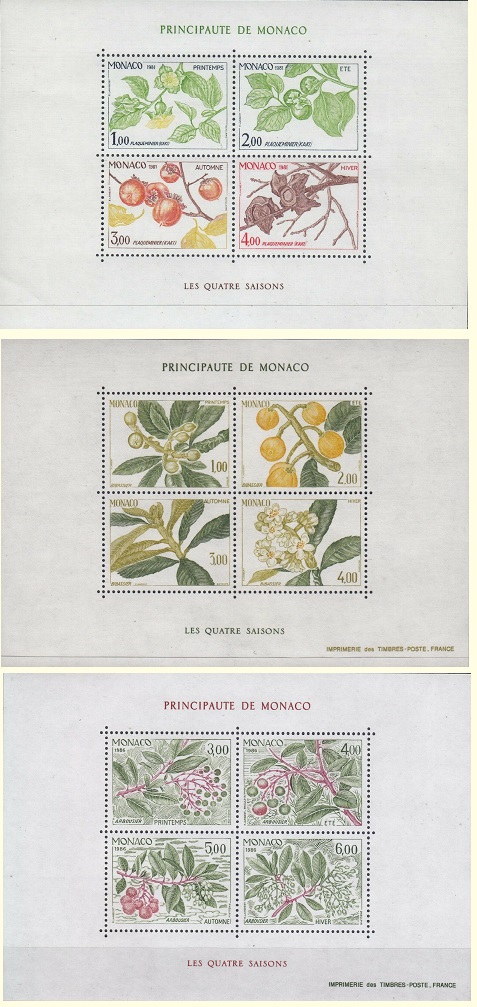
David Walker's material all related to Admiral Byrd, the Polar Explorer. These included a French poster, a North Pole handbook, Welcome Home letters, a Romanian postcard of the Bay of Whales, a Christmas card from Uruguay, a souvenir of his visit to the Pitcairn Islands, a Shell fuel token, other 1930s letters sent by Airmail from the USA, a Freemason cover, and a 1956 letter from Byrd himself.
Patrick Reid showed items that he had bought to add to his Tasmania collection for a display to the Royal Philatelic Society London in October. This included Colour Trials for the Pictorial issue, Die Proofs for the sideface issue, proof lettercards, a remarkable Postage Due cover and a range of covers showing use of the Pictorial issue.
Mark Bailey concluded proceedings with material for his collection based around the 1840-1940 Centenary of Stamps issue. This included souvenir cards from the Budapest Exhibition of 1940 and promotional labels, a German stamp dealer's advertising card using the Centenary issue, and souvenirs and covers from events in Milan and Viareggio. These were followed by items from Canada, including a photo of a block of 1d black on a cover from Hamilton. Next came a prospectus for the RPSL event, and souvenirs and a catalogue. Finally, he showed a range of material related to the miniature sheet of Classic Stamps being issued for the 150th Anniversary of the RPSL including as a sheet of 10 x miniature sheets as sold by Royal Mail.
Mark thanked all who had brought material to show.
